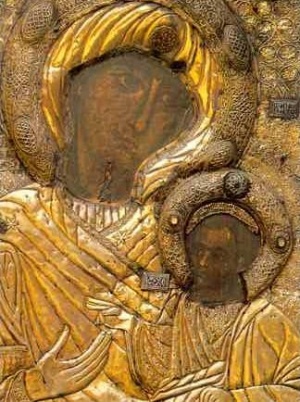The icon Panagia Portaitissa ("She who resides by the door" or "Keeper of the gate") also known as Theotokos Iverskaya, and more recently the Iveron Mother of God, is a wonder-working icon of the Theotokos.
The official icon of Mount Athos is the Panagia Axion Estin, however, this icon is the most popular. It is a pre-iconoclastic Byzantine icon, with dimensions of 1.37 x 0.94 m. The entire icon is encased by an 1819 gold and silver shirt covering the entire icon except for the faces. The most unique characteristic of the image is what appears to be a scar on the chin of the Virgin.
History of the icon
This is the most famous and most revered miraculous icon of the Theotokos on the Holy Mountain. In the 9th century, during the reign of Theophilus the Iconoclast, it was the personal property of a devout widow from Nicea in Asia Minor, who kept it and honored it in her private chapel. The emperor's men who heard of this decided not to carry out immediately the order about icons, but tried to blackmail its rich owner. In the time which they gave her to collect the money they demanded, the widow took the icon and her dearly loved son and, after fervent prayer, took it to the sea and left it on the surface of the waves, so that it should not be defiled by the iconoclasts. The icon stood upright on the water and began to head towards the west, while the widow's son, following her advice, also fled towards the west to escape persecution. Later he became a monk and died on the north-east coast of Mount Athos near or in the Monastery of Clement (now Iviron Monastery), and so the anchorites round about heard from him the story of the icon.
One evening, when monks from Georgia (Caucasian Iberians) had started to live at the Monastery of Clement, an amazing phenomenon puzzled all the monks of the area: a column of fire stood upright on the sea and reached to the heavens. This vision continued to be seen for several days, and then the monks saw the icon adrift in the sea. They made their supplications to God that this priceless treasure should be given to them, and the Theotokos appeared to the devout anchorite Gabriel the Iberian and bade him to walk on the water to take the icon and to give it to the abbot and brethren of the monastery.
Nevertheless, after its reception and installation in the church, the icon repeatedly disappeared and was found above the gate of the monastery on the inside. In a dream, the Blessed Virgin told St. Gabriel that this was the place which she herself had chosen, so that she could protect the monks and not be protected by them. Thus the icon took the name of "Portaitissa," and to this day its presence in the monastery and on the Holy Mountain is regarded as a guarantee of the protection of Athonite monasticism by the Theotokos. Later, a chapel was built near the wall of the monastery in which the icon was placed, while the old entrance was closed and a grander one was built. The miracles performed by the Portaitissa are unnumbered, and are celebrated especially on August 15 and on Monday of Bright Week, when there is a procession and the finding of the icon is commemorated with a liturgy in the chapel on the shore, at the exact spot where St. Gabriel took it out of the sea.
Commissioned Versions
Moscow Version
In 1648, Patriarch Nikon of Moscow, while he was still Archimandrite of Novospassky Monastery, commissioned an exact copy of the Iviron icon to be made and sent to Russia. Almost immediately upon its arrival on October 13, the icon was glorified with numerous miracles attributed to it by the faithful. The Iverskaya Chapel was built in 1669 to enshrine the icon next to the Kremlin walls in Moscow. The chapel was the main entrance to Red Square and traditionally everyone, from the Tsar down to the lowest peasant would stop there tovenerate the icon before entering the square. After the Bolshevik Revolution of 1917, the chapel was destroyed by the Communists and the fate of the icon is unknown to this day.
Montreal Version
The Myrrh-streaming icon from Montreal in Canada is another newer version of the famous Portaitissa [1]. For the fifteen years (1982-1997), as myrrh continued to flow from the Icon, Brother Jose Muñoz-Cortes devoted himself to its care, accompanying it on numerous trips to parishes all over the United States and Canada, to South America, Australia, and Europe. A new Copy of the Montreal Myrrh-Streaming Iveron Icon began streaming Myrrh at the Russian Orthodox Church in Hawaii in 2007.[2] Several feast days during the liturgical year celebrate a few of these miracles.
See also
Notes
Sources
- The Portaitissa icon at Iveron monastery by Kriton Chryssochoidis, from Maria Vassilaki (ed.), Images of the Mother of God, Ashgate, 2005 (Church of Greece Myriobiblos Library)
External links
Feast Days
- Icon of the Mother of God "Iveron" (February 12) Orthodox icon and synaxarion
- The Iveron Icon in Mozdok (February 12)
- Appearance of the Iveron Icon of the Mother of God (March 31)
- Translation of the Iveron Icon of the Mother of God to Moscow (October 13)
- The Myrrh-streaming Icon of the Iveron Mother of God (November 11)
- Arrival of the Iveron Icon of the Mother of God in Georgia (September 26)
